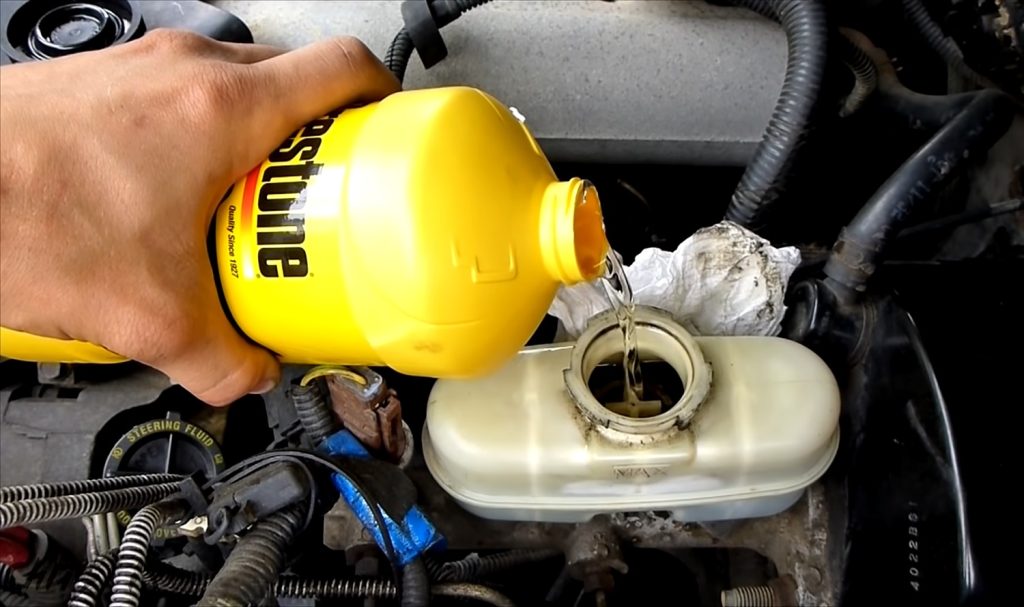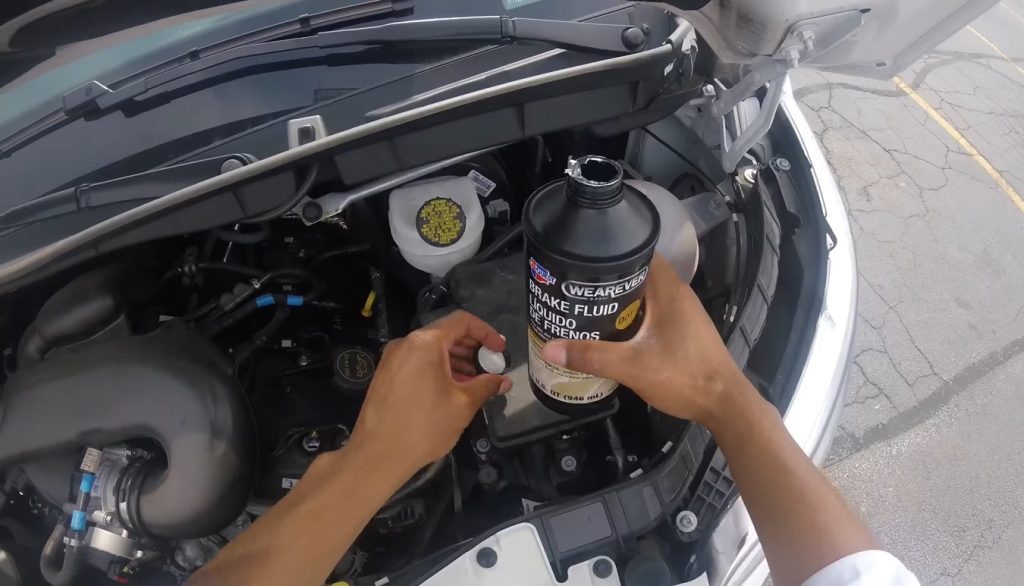
Have you ever found the brake pedal being bouncy or spongy while driving? Such things may happen when the brake fluid level goes lower than recommended. It is dangerous because lower brake fluid than recommended doesn’t allow you to brake properly. Thus, accidents may happen.
If such a situation arrives, you might think of adding the fluid while the engine is running. Is it a good decision?
What do you think? Can you add brake fluid while the car is running?
Don’t worry if you’re confused. I will discuss this in detail and suggest the best way in this article. Stay with me to have an overall idea.
Can You Add Brake Fluid while the Car is Running?
Though many people say that pouring brake fluid while the engine is on doesn’t create any issues, I suggest not doing this. I have two reasons for not supporting such action.
First, brake fluid is very corrosive in nature. Thus, if it comes in touch with any part under the hood, it instantly starts damaging the surface. When the car runs, there is a huge chance of spilling when pouring the brake fluid into the reservoir because of the vibration.
So, you can see that such action can damage components under the hood.
Second, when the engine runs, the brake lines (through which the fluid reaches the brake pad) remain in pressure. This situation makes it tough for anyone to add enough fluid. There is a high chance that the fluid level will remain lower, or you’ll pour more fluid than the recommended level.
Thus, adding fluid when the system is under pressure may leave you where you were before.
Can You Add Brake Fluid while Car is Hot?
In fact, you shouldn’t even pour the fluid when the car engine is hot. You must wait for some time after turning it off.
First, if the engine is hot, there is a high chance that the braking line is scorching hot, too. The heat can cause the new brake fluid to vaporize somehow. As a result, the braking system won’t work properly because of the vapor inside the line.
However, the scope of such incidents is rare.
Second, almost all the surfaces under the hood remain hot even after turning the engine off. There is a huge chance of fire or smoke if any portion of the fluid spills on such a hot surface. If a fire occurs, you’ll face huge damage.
Third, if any part of your body touches any of the hot surfaces, your skin will burn severely. This is another possible danger you may face if you try to add brake fluid when the engine is hot.
The two risks described in the previous part of the article are applicable in this case, too. Thus, you can see that several issues are associated with adding braking fluid while the engine is running or hot.
Related Post: Car Shaking When Braking at High Speeds – Why? How to Fix?
The Right Way to Adding Brake Fluid when It is Lower Than Recommended

From the discussion above, you can see that you shouldn’t pour brake fluid when the car is running, or the engine is hot. So, you may ask- what is the right way? ‘
For you, I’m going to share the right way to add brake fluid to the car.
Step 1- Stop the car and wait for a few minutes
First, stop the car and allow the engine to cool. It may take around 8-10 minutes.
In case your car has an ABS brake, push the brake pedal a few times. It’ll drive the fluid away from the brake channel.
You can lift the hood to cool the engine and other components fast. But be careful, because it is hot too.
Step 2- Check the fluid level
Find out the brake fluid reservoir. It is typically on the driver’s side as it is directly connected to the brake pedals.
You can see the oil level from the outside, as most reservoirs are typically translucent. Compare the level with the ‘minimum’ and ‘maximum’ levels marked on the reservoir body.
You must add fluid if the level is close to or under the ‘minimum’ line.
Besides, you should check the color. Adding new fluid will be enough if the color is clear, yellow, or even dark yellow. But if the color is dark and you can feel a lot of debris inside, you must go to a mechanic soon and replace the fluid completely.
Step 3- Add the fluid
Typically, the opening of the reservoir is wide enough to pour the fluid directly from the bottle. But you can use a funnel to stay on the safe side.
Pour the fluid from the bottle until you reach near to the maximum level. Do it carefully so the fluid level doesn’t exceed the ‘maximum’ line.
Step 4- Close the reservoir with the cap
Use the reservoir cap to close it. Tighten the cap properly to ensure no moisture or air can enter the reservoir. If such a thing happens, the fluid will get weakened. As a result, you’ll have to replace the fluid soon.
Step 5- Pump the brakes
Pumping brakes after adding brake fluid is necessary. It allows the new fluid to get mixed with the old one. Besides, pumping pushes the new oil to travel the brake line. You’ll still feel that spongy or bouncy pedal if you don’t pump.
So, push the brake pedal down and allow it to come back. Maintain a constant pressure. Also, don’t push it all the way. Do this about 30 times or until you feel the pressure from the pedal like before. Once you feel it, know you’ve successfully added brake fluid to your vehicle. If you want to learn more about the full process of brake pumping after adding brake fluid, we have found this article more informative and useful for you!
Is It Okay to Mix New Fluid with Old Fluid?

Yes, you can do this. In fact, doing this is great. It allows the new fluid to adopt the system easily.
However, there is a caution.
Both fluids must have similar chemical composition. In easier words- you can mix them only if they are the same fluids.
Fluids with different chemical compositions won’t get mixed completely. As a result, your braking system won’t work properly. You may face several other problems.
I suggest always buying the same brake fluid to avoid such situations.
Which Brake Fluid Should You Use?
Brake fluid differs from engine oil or any other fluid you use in your car. So, while adding the fluid, you must be careful about the one you’re using.
I always suggest applying the fluid recommended by the vehicle manufacturer. They recommend the most compatible one with the braking system used. You’ll get the suggestion in the user manual.
Also, you may find that online if you search properly.
However, if you’ve replaced the stock braking system with a new one, there’s a chance that the vehicle manufacturer’s recommendation won’t work. In this case, you should look for the suggestion from the baking system manufacturer.
Bake fluids come with low viscosity for better flow through the brake line. Other fluids used in the car for different purposes are not the same. So, to stay safe and save your buck, don’t add any fluid other than the brake fluid manufacturer recommends.
Frequently Asked Questions (FAQ)
How long can you drive with low brake fluid?
It is not wise to run a car with low brake fluid. In such situations, you can’t put enough pressure on the brake to make it work properly. It’ll take more time to stop. This condition may result in severe accidents.
So, I recommend changing it as fast as possible.
However, drive carefully if you don’t have the fluid and no mechanic shop is nearby. Don’t speed up. Also, avoid driving too close to the vehicle in your front.
How often do you need to add brake fluid?
You need to add brake fluid whenever it goes lower than the minimum level marked on the reservoir. But the good news is it doesn’t drain fast if there is no leak in the system. So, you can easily drive for years after adding the fluid once.
Still, I suggest checking fluid levels once a month. It’ll help you understand if there is a leak in the system.
Why is my brake fluid low but no leaks?
This situation occurs when your brake pad is worn out. Also, some damage in brake drums or discs causes such an issue.
So, if the brake fluid runs low often, but there is no wear in the system, check your brake pad, drum, and disc. Maybe you need to replace something.
How to Change Car Brake Fluid [ Expert Video]
Final Verdict
I guess now you’ve understood why you shouldn’t try adding brake fluid while the car runs or is hot. Even if some say that it won’t have any negative impact, any accident can occur at any time as there is enough scope for it.
So, stop the car, allow it some time to cool, and then add the fluid following the process I’ve shared. In this way, both you and your car will be safe from accidents likely to happen.






